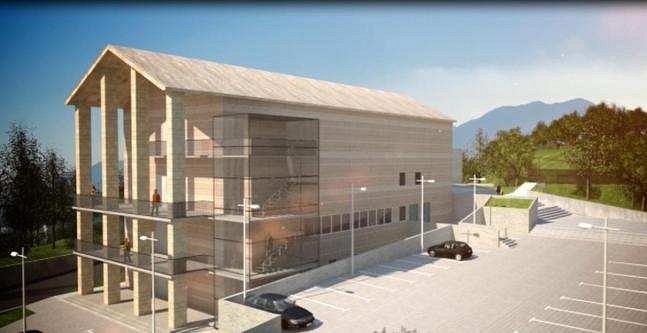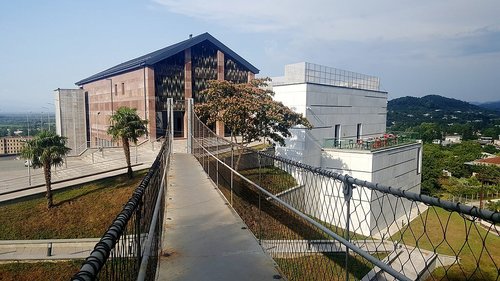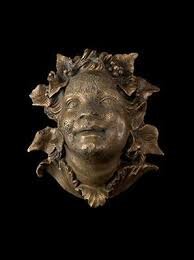Vani Archaeological Museum, Imereti Region, Georgia
4.0 (5 reviews) Spent Ranking #1 in Vani Speciality Museums • History Museums

advised everyone interested in ancient culture
the archaeological museum of Vani (near Kutaisi) is already open! and presents amazing finds from the ancient city of Leucothea (VIII-VII centuries BC). We were delighted with jewelry made using a unique technique (tsvari), clay mythical figurines, and exquisite bronze items. Excavations have been conducted not very long ago and not very seriously (in our opinion). Provided that the international archaeological community is interested in this site, we are sure that these excavations will rank in importance with Pompey, Knossos and other pearls of antiquity. we advise everyone interested in ancient culture











Address
O. Lortkipanidze St., 32, Vani, Georgia.
Mobile
Website
http://museum.ge/?lang
Current local date and time now
Monday, May 13, 2024, 4:39
User Ratings
4.0 based on (5 reviews)
Reviews
-
5TATA 5:00 PM Nov 28, 2019
exploring trejure of Georgia
amazing place for viziting and exploring trejure of Georgia .Vani (Georgian: ვანი) is a town in Imereti region of western Georgia, at the Sulori river (a tributary of the Rioni river), 41 km southwest from the regional capital Kutaisi. The town with the population of 3,744 (2014) is an administrative center of the Municipality of Vani comprising also 40 neighbouring villages (total area – 557 km²; population – 24,512, 2014). Systematic archaeological studies (N.Khoshtaria, O.Lortkiphanidze) carried out in the Vani environs since 1947 revealed the remnants of a rich city of the ancient power of Colchis. The name of this ancient settlement is still unknown but four distinct stages of uninterrupted occupation have been identified. The first phase is dated to the 8th to 7th centuries BC. In this period Vani is presumed to have been a major cultic centre. The second phase - end of the 7th and beginning of the 6th to the first half of the 4th century BC - is represented by cultural layers, remains of wooden structures, sacrificial altars cut in the rocky ground, and rich burials. It is assumed that on this stage Vani was the centre of a political-administrative unit of the kingdom of Colchis. The third phase covers the second half of the 4th to the first half of the 3rd century BC. It is represented largely by rich burials, remains of stone structures. To the fourth phase (3rd to mid-1st centuries BC) belong defensive walls, the so-called small gate, sanctuaries and cultic buildings (temples, altars sacrificial platforms), and the remains of a foundry for casting bronze statues. It is assumed that in the 3rd to 1st centuries BC. Vani was a templar city. According to the archaeological data, the city was destroyed in the mid-1st century BC. Subsequently, Vani declined to a village and was officially granted a status of a town only in 1981. In town Vani there is an interesting museum (founded in 1985), where some unique pieces of the ancient Colchis are exhibited.

See also
More Things to do in Vani
- Points of Interest & Landmarks in Vani
- Architectural Buildings in Vani
- Churches & Cathedrals in Vani
- Historic Sites in Vani
- Ancient Ruins in Vani
- Observation Decks & Towers in Vani
- Art Museums in Vani
- Speciality Museums in Vani
- History Museums in Vani
- Religious Sites in Vani
- Parks in Vani
- Castles in Vani
- Bridges in Vani
- Historic Walking Areas in Vani
- Gardens in Vani
- Trams in Vani
- Mountains in Vani
- Marinas in Vani
- Waterfalls in Vani
- Wineries & Vineyards in Vani
- Nature & Wildlife Areas in Vani
- Spas in Vani
- Cooking Classes in Vani
- Speciality & Gift Shops in Vani
- 4WD, ATV & Off-Road Tours in Vani
- Private Tours in Vani
- Taxis & Shuttles in Vani
- Health Clubs in Vani
- Scuba & Snorkelling in Vani
- Boat Tours in Vani
- Sightseeing Tours in Vani
- Equestrian Trails in Vani
- Horseback Riding Tours in Vani
- Cultural Tours in Vani
- Night Tours in Vani
- Lookouts in Vani
- Monuments & Statues in Vani
- Neighborhoods in Vani
- Bodies of Water in Vani
- Theaters in Vani
- Zoos in Vani
- Geologic Formations in Vani
- Beaches in Vani
- Dams in Vani
- National Parks in Vani
- Ferries in Vani
- Hiking Trails in Vani
- Game & Entertainment Centers in Vani
- Biking Trails in Vani
- Scenic Walking Areas in Vani
- Escape Games in Vani
- Adrenaline & Extreme Tours in Vani
- Zipline & Aerial Adventure Parks in Vani
- Nature & Wildlife Tours in Vani
- Farms in Vani
- Speed Boats Tours in Vani
- Walking Tours in Vani
- Ranches in Vani
- Shopping Malls in Vani
- Water Parks in Vani
- Amusement & Theme Parks in Vani
- Observatories & Planetariums in Vani
- Beach & Pool Clubs in Vani
- Children's Museums in Vani
- Flea & Street Markets in Vani
- Visitor Centers in Vani
- Sports Camps & Clinics in Vani
- Breweries in Vani
- Lessons & Workshops in Vani
- Islands in Vani
- Ghost Towns in Vani
- Caverns & Caves in Vani
- Golf Courses in Vani
- Movie Theaters in Vani
- Art Galleries in Vani
- Antique Shops in Vani
- Educational sites in Vani
- Sports Complexes in Vani
- Government Buildings in Vani
- Theatre & Performances in Vani
- Horse Tracks in Vani
- Aquariums in Vani
- Cemeteries in Vani
- Military Museums in Vani
- Scenic Drives in Vani
- Deserts in Vani
- Operas in Vani
- Science Museums in Vani
- Ski & Snowboard Areas in Vani
- Libraries in Vani
- Playgrounds in Vani
- Arenas & Stadiums in Vani
- Farmers Markets in Vani
- Natural History Museums in Vani
- Rides & Activities in Vani
- Battlefields in Vani
- Kayaking & Canoeing in Vani
- Bars & Clubs in Vani
- Fishing Charters & Tours in Vani
- Historical & Heritage Tours in Vani
- Lighthouses in Vani
- Distilleries in Vani
- Casinos in Vani
- Convention Centers in Vani
- Cultural Events in Vani
- Dance Clubs & Discos in Vani
- Beer Tastings & Tours in Vani
- Food Tours in Vani
- Factory Tours in Vani
- Photography Tours in Vani
- Distillery Tours in Vani
- Ghost & Vampire Tours in Vani
- Segway Tours in Vani
- Shopping Tours in Vani
- Self-Guided Tours & Rentals in Vani
- River Rafting & Tubing in Vani
- Helicopter Tours in Vani
- Air Tours in Vani
- Civic Centres in Vani
- State Parks in Vani
- Bike Tours in Vani
- Paint & Pottery Studios in Vani
- Mines in Vani
- Missions in Vani
- Ships in Vani
- Surfing & Windsurfing in Vani
- Gear Rentals in Vani
- Symphonies in Vani
- Cabarets in Vani
- Wine Bars in Vani
- Ski & Snow Tours in Vani
- Rail Services in Vani
- Shooting Ranges in Vani
- Auto Racing Tracks in Vani
- Department Stores in Vani
- Off-Road & ATV Trails in Vani
- Rail Tours in Vani
- Balloon Rides in Vani
- Boat Rentals in Vani
- Dinner Theaters in Vani
- Factory Outlets in Vani
- Cross-country Ski Areas in Vani
- Music Festivals in Vani
- Bowling Alleys in Vani
- Water Sports in Vani
- Coffeehouses in Vani
- Yoga & Pilates in Vani
- Miniature Golf in Vani
- Scavenger Hunts in Vani
- Scenic Railroads in Vani
- Other Outdoor Activities in Vani
- Wedding Chapels in Vani
- Concerts in Vani
- Airport Shops in Vani
- Cigar Bars in Vani
- Comedy Clubs in Vani
- Food & Drink Festivals in Vani